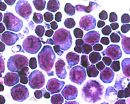(Press-News.org) STANFORD, Calif. — A molecule critical to stem cell function plays a major role in determining human hair color, according to a study from the Stanford University School of Medicine.
The study describes for the first time the molecular basis for one of our most noticeable traits. It also outlines how tiny DNA changes can reverberate through our genome in ways that may affect evolution, migration and even human history.
"We've been trying to track down the genetic and molecular basis of naturally occurring traits — such as hair and skin pigmentation — in fish and humans to get insight into the general principles by which traits evolve," said David Kingsley, PhD, professor of developmental biology. "Now we find that one of the most crucial signaling molecules in mammalian development also affects hair color."
Kingsley, who is also a Howard Hughes Medical Institute investigator, is the senior author of the study, which will be published online June 1 in Nature Genetics. Research specialist Catherine Guenther, PhD, is the lead author.
The researchers found that the blond hair commonly seen in Northern Europeans is caused by a single change in the DNA that regulates the expression of a gene that encodes a protein called KITLG, also known as stem cell factor. This change affects how much KITLG is expressed in the hair follicles without changing how it's expressed in the rest of the body. Introducing the change into normally brown-haired laboratory mice yields an animal with a decidedly lighter coat — not quite Norma Jeane to Marilyn Monroe, but significant nonetheless.
The study shows that even small, tissue-specific changes in the expression of genes can have noticeable morphological effects. It also emphasizes how difficult it can be to clearly connect specific DNA changes with particular clinical or phenotypic outcomes. In this case, the change is subtle: A single nucleotide called an adenine is replaced by another called a guanine on human chromosome 12. The change occurs over 350,000 nucleotides away from the KITLG gene and only alters the amount of gene expression about 20 percent — a relatively tiny blip on a biological scale more often assessed in terms of gene expression being 100 percent "on" or "off."
"What we're seeing is that this regulatory region exercises exquisite control over where, and how much, KITLG expression occurs," said Kingsley. "In this case, it controls hair color. In another situation — perhaps under the influence of a different regulatory region — it probably controls stem cell division. Dialing up and down the expression of an essential growth factor in this manner could be a common mechanism that underlies many different traits."
Kingsley is known for his studies of the evolution of a tiny fish called the threespine stickleback. The stickleback adapts quickly to changes in its environment. It becomes darker in murky lakes, and develops modified spine, fin and armor structures in response to different types of predators. Kingsley's research has shown that these adaptive changes are often driven by changes in the regulatory regions that surround and control gene expression, rather than within the coding regions of the genes themselves.
In the current study, the researchers had a couple of clues as to which regulatory regions might be important in hair color. One was the fact that the adenine-to-guanine nucleotide change had been previously associated with blond hair color in Northern Europeans in genome-wide association studies. The second was the existence in laboratory mice of a large mutation called an inversion that affects several million nucleotides near the KITLG gene. Mice with two copies of this mutation (one on each chromosome) are white; those with just one copy are significantly lighter than wild-type mice. But it wasn't known exactly how either of these changes affects hair pigment.
The researchers began by confirming that the mouse mutation occurs in a region that is similar, or homologous, to where the single nucleotide change occurs in humans. They also showed that the skin of mice with one copy of the mutation expressed about 60 percent the amount of KITLG as the skin of mice without the mutation.
Further study showed that the region of human DNA that contained the single nucleotide change associated with blondness specifically affected the expression of KITLG only in hair follicles.
Finally, the researchers replaced the mouse mutation with human sequences with and without the blond-associated nucleotide change. Those with the guanine tied to blond hair in humans did in fact have significantly lighter hair.
"Because this nucleotide switch only effects the KITLG expression by about 20 percent or so, it would have been difficult to believe it would have such an effect on hair color," Kingsley said. "For that we needed these very carefully constructed, well-controlled animal models. They clearly showed us that this small difference in expression is enough to switch hair color in these animals."
He added: "It's clear that this hair color change is occurring through a regulatory mechanism that operates only in the hair. This isn't something that also affects other traits, like intelligence or personality. The change that causes blond hair is, literally, only skin deep."
INFORMATION:
Other Stanford authors of the study are former postdoctoral scholar Bosiljka Tasic, PhD, and professor of biology Liqun Luo, PhD.
The research was funded by the National Institutes of Health (grant 5P50HG2568) and the Howard Hughes Medical Institute.
Information about Stanford's Department of Developmental Biology, which also supported the work, is available at http://devbio.stanford.edu.
The Stanford University School of Medicine consistently ranks among the nation's top medical schools, integrating research, medical education, patient care and community service. For more news about the school, please visit http://mednews.stanford.edu. The medical school is part of Stanford Medicine, which includes Stanford Hospital & Clinics and Lucile Packard Children's Hospital Stanford. For information about all three, please visit http://stanfordmedicine.org/about/news.html.
Subtle change in DNA, protein levels determines blond or brunette tresses, study finds
2014-06-01
ELSE PRESS RELEASES FROM THIS DATE:
International collaboration replicates amplification of cosmic magnetic fields
2014-06-01
VIDEO:
This video simulation shows how a laser that illuminates a small carbon rod launches a complex flow, consisting of supersonic shocks and turbulent flow. When the grid is present, turbulence...
Click here for more information.
Astrophysicists have established that cosmic turbulence could have amplified magnetic fields to the strengths observed in interstellar space.
"Magnetic fields are ubiquitous in the universe," said Don Lamb, the Robert A. Millikan Distinguished ...
Researchers discover hormone that controls supply of iron in red blood cell production
2014-06-01
A UCLA research team has discovered a new hormone called erythroferrone, which regulates the iron supply needed for red blood-cell production.
Iron is an essential functional component of hemoglobin, the molecule that transports oxygen throughout the body. Using a mouse model, researchers found that erythroferrone is made by red blood-cell progenitors in the bone marrow in order to match iron supply with the demands of red blood-cell production. Erythroferrone is greatly increased when red blood-cell production is stimulated, such as after bleeding or in response to anemia.
The ...
Leptin also influences brain cells that control appetite, Yale researchers find
2014-06-01
Twenty years after the hormone leptin was found to regulate metabolism, appetite, and weight through brain cells called neurons, Yale School of Medicine researchers have found that the hormone also acts on other types of cells to control appetite.
Published in the June 1 issue of Nature Neuroscience, the findings could lead to development of treatments for metabolic disorders such as obesity and diabetes.
"Up until now, the scientific community thought that leptin acts exclusively in neurons to modulate behavior and body weight," said senior author Tamas Horvath, the ...
Mayo Clinic: Ovarian cancer subtypes may predict response to bevacizumab
2014-06-01
CHICAGO — Molecular sequencing could identify ovarian cancer patients who are most likely to benefit from treatment with bevacizumab (Avastin), a Mayo Clinic-led study has found. Results of the research were presented today at the 2014 American Society of Clinical Oncology Annual Meeting.
The addition of bevacizumab to standard therapy extended progression-free survival more for ovarian cancer patients with molecular subtypes labeled as "proliferative" or "mesenchymal" compared to those with subtypes labeled as "immunoreactive" or "differentiated," says Sean Dowdy, M.D., ...
Oncologists: How to talk with your pathologist about cancer molecular testing
2014-06-01
As targeted therapies become more available, increasing opportunity exists to match treatments to the genetics of a specific cancer. But in order to make this match, oncologists have to know these genetics. This requires molecular testing of patient samples. An education session presented today at the American Society for Clinical Oncology (ASCO) Annual Meeting 2014 details the challenges in this process and makes recommendations that oncologists can use to ensure their patients' samples are properly tested, helping to pair patients with the best possible treatments.
"The ...
Chemotherapy following radiation treatment improves progression-free survival
2014-06-01
CHICAGO — A chemotherapy regimen consisting of procarbazine, CCNU, and vincristine (PCV) administered following radiation therapy improved progression-free survival and overall survival in adults with low-grade gliomas, a form of brain cancer, when compared to radiation therapy alone. The findings were part of the results of a Phase III clinical trial presented today at the 2014 American Society of Clinical Oncology Annual Meeting by the study's primary author Jan Buckner, M.D., deputy director, Cancer Practice, at Mayo Clinic Cancer Center.
"On average, patients who ...
New report estimates nearly 19 million cancer survivors in the US by 2024
2014-06-01
ATLANTA – June 1, 2014 – The number of cancer survivors in the United States, currently estimated to be 14.5 million, will grow to almost 19 million by 2024, according to an updated report by the American Cancer Society. The second edition of Cancer Treatment & Survivorship Facts & Figures, 2014-2015 and an accompanying journal article published in CA: A Cancer Journal for Clinicians find that even though cancer incidence rates have been decreasing for ten years, the number of cancer survivors is growing. This is the result of increases in cancer diagnoses driven by the ...
Reducing emissions will be the primary way to fight climate change, UCLA-led study finds
2014-06-01
Forget about positioning giant mirrors in space to reduce the amount of sunlight being trapped in the earth's atmosphere or seeding clouds to reduce the amount of light entering earth's atmosphere. Those approaches to climate engineering aren't likely to be effective or practical in slowing global warming.
A new report by professors from UCLA and five other universities concludes that there's no way around it: We have to cut down the amount of carbon being released into the atmosphere. The interdisciplinary team looked at a range of possible approaches to dissipating ...
ALTTO test of dual HER2 blockade finds single agent remains the gold standard
2014-06-01
CHICAGO — June 1, 2014 — In the largest clinical trial testing the effectiveness of one versus two drugs to treat HER2-positive breast cancer, lapatinib (Tykerb) did not add benefit to the standard trastuzumab (Herceptin) adjuvant therapy, researchers report at the 50th annual meeting of the American Society of Clinical Oncology (ASCO).
MULTIMEDIA ALERT: Video and audio are available for download on the Mayo Clinic News Network.
Results of the phase III clinical trial, ALTTO (Adjuvant Lapatinib and/or Trastuzumab Treatment Optimization study), demonstrated that adding ...
The ethics of knowing where to stop treatment in a sick and elderly patient
2014-06-01
An Emeritus Professor of medical ethics at Imperial College London will deliver a presentation at this year's Euroanaesthesia meeting titled 'Escalating care for the comorbid elderly-where do we stop?". Raanan Gillon, who is President of the UK's Institute of Medical Ethics, will argue that a patient's age should not in itself be considered an ethically relevant criterion for deciding 'where to stop'.
Acknowledging that there is a morally plausible counter-argument – known in the UK as 'the fair innings argument'- according to which scarce life prolonging resources should ...

